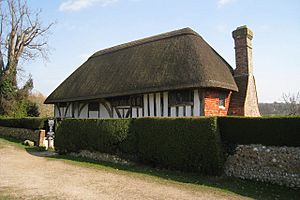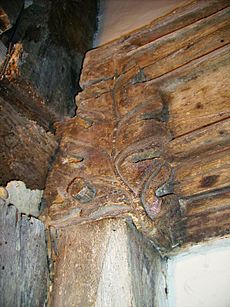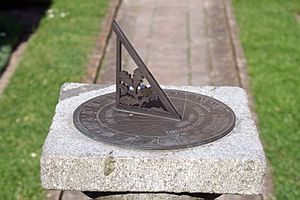Alfriston Clergy House facts for kids
Quick facts for kids Alfriston Clergy House |
|
|---|---|

The house in spring
|
|
| Type | Wealden hall house |
| Location | Alfriston |
| OS grid reference | TQ 52131 02951 |
| Area | East Sussex |
| Built | Mid-14th Century |
| Owner | National Trust |
|
Listed Building – Grade II*
|
|
| Official name: The Old Clergy House | |
| Designated | 13 October 1952 |
| Reference no. | 1191431 |
| Lua error in Module:Location_map at line 420: attempt to index field 'wikibase' (a nil value). | |
The Alfriston Clergy House is a very old building in Alfriston, East Sussex, England. It was the very first property bought by the National Trust in 1896 for just £10. This house is right next to the Church of St. Andrew. It is a special building, listed as Grade II*, which means it's historically important. Today, you can visit the house and explore its history.
Contents
History of the House
This house is a type of building called a Wealden hall house, built in the 1300s. Even though it's called the "Clergy House" (meaning a priest's house), it was first built for a farmer. It's a simple, small home, not like the big houses many priests lived in later.
The house has low ceilings and two floors. It's made with a wooden frame and has a thatched roof (a roof made of straw or reeds). Some parts of the house were rebuilt in the 1600s.
There's a cool detail inside: a wood carving of an oak leaf. Some people say this carving might have inspired the National Trust's famous leaf symbol, but there's no proof. The house also has a rare floor made from chalk and sour milk, which was like an early type of cement. Outside, there's a pretty cottage garden designed by Graham Stuart Thomas.
How the National Trust Saved It
The National Trust made important decisions about how to fix and care for the Clergy House in 1895. These decisions helped shape how they would look after almost all their properties from then on. It also encouraged a more careful way of restoring old buildings across the country.
This careful approach came from the close connection between the new National Trust and the Society for the Protection of Ancient Buildings (SPAB). The SPAB was started by William Morris many years earlier. He wanted to stop "excessive restoration," which meant fixing old buildings too much and making them lose their original charm. The people who started the National Trust agreed with William Morris. They were worried about the damage done to old buildings, especially churches, in the name of "restoration."
Saving a Special Building
By 1890, the Clergy House was in very bad shape. The new priest, Reverend F. W. Beynon, asked an architect for advice on repairs. In 1891, he contacted the SPAB for help. They managed to raise £124 for some work, but the project faced problems.
In 1894, Reverend Beynon asked the SPAB if the new National Trust might be interested in taking over the Clergy House. The SPAB connected him with Canon Rawnsley, one of the National Trust's founders. Before buying the house, another founder, Octavia Hill, also asked the SPAB for advice. She wrote that they would need to "restore" it, but only to "preserve from decay," meaning to stop it from falling apart, not to change it too much.
A New Way to Restore
This idea of not over-restoring was confirmed by the National Trust in March 1895. They decided that "restoration means such work as may be necessary to the preservation of the building with as little new work as possible." This rule became the standard for all the historic buildings they would acquire later.
In June, the Church authorities agreed to sell the building for just £10. Octavia Hill then asked the SPAB to suggest an architect who would truly care about the building and oversee the repairs carefully. The SPAB suggested Alfred Powell, who did the repair work. Even though the National Trust's first fundraising appeal for the house didn't raise much money, the work was completed.
Because of this early teamwork, the National Trust and SPAB developed a strong working relationship that continues today. Many of the National Trust's properties, from large country houses to small cottages, have been repaired by architects trained by the SPAB. They all follow the careful conservation rules first put into practice at the Alfriston Clergy House.



